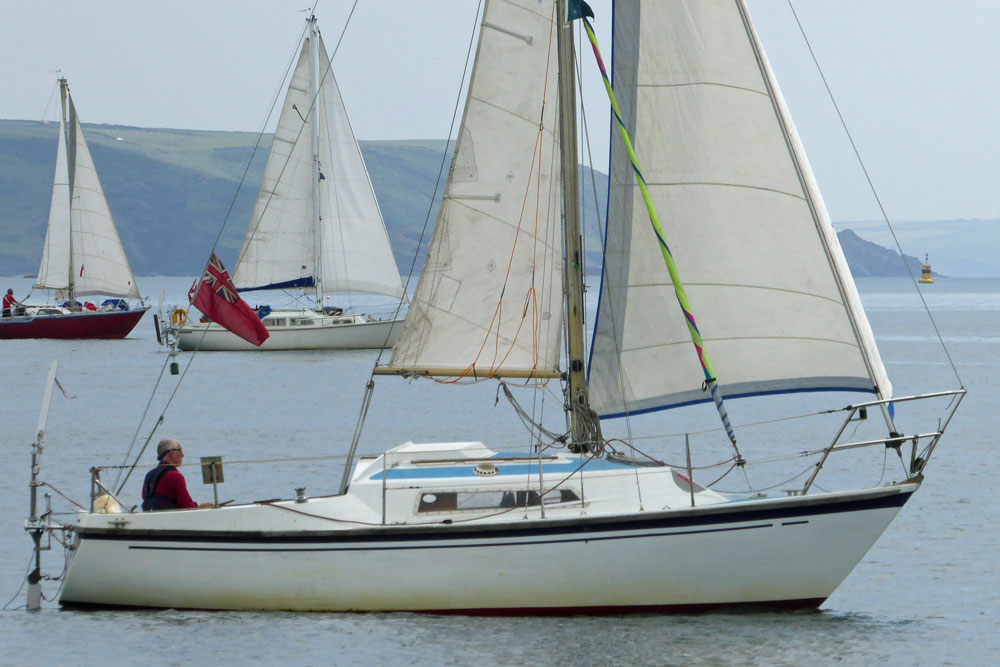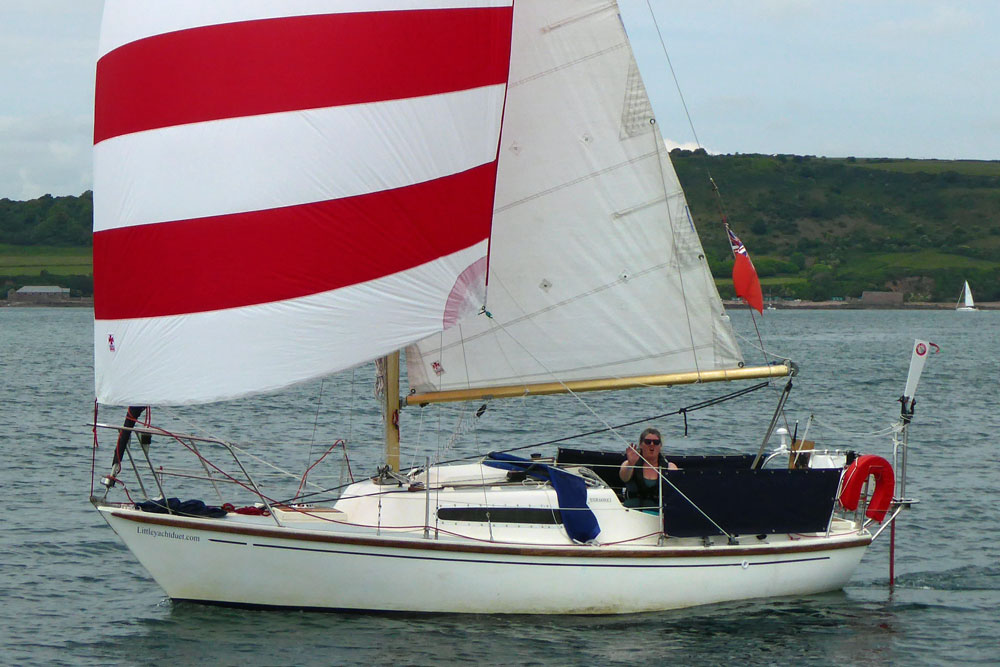- Home
- Cruiser Yachts under 30'
- Hurley 24
The Hurley 24 Sailboat
Specs & Key Performance Indicators
The Hurley 24 was designed by Ian Anderson and built in the UK by Hurley Marine Ltd.
 The windvane self-steering gear and the retro-fitted staysail on this Hurley 24 suggests the skipper has a long-distance passage in mind.
The windvane self-steering gear and the retro-fitted staysail on this Hurley 24 suggests the skipper has a long-distance passage in mind.Published Specification for the Hurley 24
Underwater Configuration: Fin with skeg-hung rudder
Hull Material: GRP (fibreglass)
Length Overall: 23' 9" / 7.24m
Waterline Length: 17' 6" / 5.33m
Beam: 7' 5" / 2.26m
Draft: 4' 1" / 1.24m
Rig Type: Masthead Sloop
Displacement: 5,096lb / 2,312kg
Designer: Ian Anderson
Builder: Hurley Marine Ltd (UK)
Year First Built: 1972
Owners Association: Hurley Owners Association
Published Design Ratios for the Hurley 24
1. Sail Area/Displacement Ratio: 13.6
2. Ballast/Displacement Ratio: 61
3. Displacement/Length Ratio: 342
4. Comfort Ratio: 22.7
5. Capsize Screening Formula: 1.9
Performance Predictions, Based on the Design Ratios
The Hurley 24 is a heavy displacement cruising boat with a fin and skeg hull form and a reverse-counter transom. She has a high-aspect rig with a short boom and a large genoa, which gives her good performance in light winds. She also has a high ballast ratio, which makes her stiff and stable in strong winds. She can handle rough seas well and has a low capsize risk.
Based on the design ratios, we can predict the following performance characteristics of the Hurley 24:
- Sail Area/Displacement Ratio: 13.6. This means that she is under-powered and needs a stiff breeze to get her going. She might need to motor-sail in light or calm conditions.
- Ballast/Displacement Ratio: 61. This means that she is very stiff and powerful and can stand up well to her canvas in a blow. She can power through the waves and maintain speed.
- Displacement/Length Ratio: 342. This means that she is a heavy displacement cruising boat. She can carry a lot of cruising gear and equipment without affecting her waterline. She is not very fast or agile, but she is comfortable and seaworthy.
- Comfort Ratio: 22.7. This means that she has a moderate comfort level for offshore cruising. She might not be very smooth or gentle in a seaway, but she is not too harsh or violent either.
- Capsize Screening Formula: 1.9. This means that she is well suited for ocean passages and has a low risk of capsizing.
Production Period and Numbers Produced
The Hurley 24 was designed in 1972 as a stretched version of the Hurley 22. She was intended to appeal to the European market and was named after her length in feet and meters (24/70). She was built by Hurley Marine Ltd. until 1974, when the company closed down. About 200 Hurley 24s were produced during this period.
After the closure of Hurley Marine Ltd., the moulds were taken over by Atlanta Marine, who modified them by lengthening the hull by 12 inches. The new boat was marketed as the Atlanta 24 and later as the Atlanta 25. These boats were sold in small numbers until about 1977. They look very similar to the Hurley 24, but have slightly different dimensions and specifications.
Alternative Versions & Options
The Hurley 24 was available in two versions: fin keel or bilge keel. The fin keel version has better performance and manoeuvrability, while the bilge keel version has better stability and shallow draft. The bilge keel version also allows the boat to dry out on tidal moorings.
Most Hurley 24s were fitted with small petrol or diesel inboard engines, such as Vire 5hp, Petter Mini Twin, Yanmar 1GM10, Beta 13hp, BMW D12, or Farryman 7hp. Some Hurley 24s were supplied with outboard engines on brackets attached to the stern. These boats were slightly cheaper and lighter than the inboard versions.
The Hurley 24 has a masthead sloop rig with a short boom and a large genoa. Some owners have added a staysail or a spinnaker to increase sail area and versatility. Some owners have also installed windvane self-steering gear to make long-distance sailing easier.
The Hurley 24 has a spacious interior with two separate cabins. The main saloon has two settee berths, a folding table, a galley, and a navigation station. The forward cabin has two V-berths and an enclosed head compartment.
Number & Location of Sleeping Berths
The Hurley 24 has four sleeping berths in two separate cabins. The main saloon has two settee berths, one on each side of the boat. These berths are six feet long and can accommodate adults comfortably. The forward cabin has two V-berths, which can be converted into a double berth with an infill cushion. These berths are also six feet long and can fit adults or children.
History of the Boatbuilder
Hurley Marine Ltd. was founded by George Hurley in 1960 in Plymouth, UK. The company started by building wooden boats, such as the Hurley 18 and the Hurley 22. In 1964, the company switched to fiberglass construction and became one of the pioneers of mass-produced GRP boats in the UK. The company expanded its range of boats to include the Hurley 20, the Hurley 27, the Hurley 30/90, and the Hurley 24/70.
Hurley Marine Ltd. was known for building high-quality, seaworthy, and affordable boats that appealed to a wide range of sailors. The company won several awards and recognition for its boats, such as the Yachting World Design Award for the Hurley 22 in 1965 and the British Boat Show Award for the Hurley 30/90 in 1971. The company also exported its boats to many countries, such as France, Germany, Holland, Sweden, Norway, Denmark, USA, Canada, Australia, and New Zealand.
However, in 1974, Hurley Marine Ltd. faced financial difficulties due to the oil crisis and the recession. The company was forced to close down and sell its assets. The moulds for some of its boats were bought by other boatbuilders, such as Atlanta Marine, South Coast Marine, and Trident Marine. Some of these boatbuilders continued to produce modified versions of Hurley boats under different names.
Secondhand Values
The Hurley 24 is a popular and sought-after boat among secondhand buyers. She is valued for her classic design, solid construction, spacious interior, and good performance. She is also easy to maintain and repair, as spare parts are readily available from other Hurley owners or suppliers.
The secondhand values of Hurley 24s vary depending on their condition, age, equipment, and location. According to [YachtWorld], a global online marketplace for boats, the average asking price for a Hurley 24 in 2021 was £5,000 (about $6,900 USD). The lowest asking price was £2,500 (about $3,450 USD) and the highest asking price was £8,000 (about $11,000 USD).
The secondhand values of Hurley 24s are likely to increase in the future, as they become more rare and collectable. They are also likely to retain their value well, as they are durable and reliable boats that can last for decades with proper care.
Press Reviews
The Hurley 24 has received positive reviews from various sailing magazines and websites over the years. Here are some excerpts from some of these reviews:
- "The Hurley 24/70 is a well-built cruiser that offers good accommodation for her size. She is easy to handle and sails well in most conditions. She is ideal for coastal cruising or longer passages with a small crew." [Practical Boat Owner], June 2010
- "The Hurley 24/70 is a classic cruiser with a modern twist. She has a fin and skeg hull form that gives her good performance and manoeuvrability. She also has a high-aspect rig that makes her responsive and versatile. She is comfortable and spacious below decks, with two separate cabins and an enclosed heads. She is a great boat for family sailing or solo adventures." [Sailing Today], August 2012
- "The Hurley 24/70 is a heavy displacement cruising boat that can handle rough seas well. She has a high ballast ratio that makes her stiff and stable in strong winds. She also has a low capsize risk that makes her safe for ocean passages. She is not very fast or agile, but she is comfortable and seaworthy. She is a boat that will take you anywhere you want to go." [Yachting Monthly], October 2014
The above text was drafted by sailboat-cruising.com using GPT-4 (OpenAI’s large-scale language-generation model) as a research assistant to develop source material; we believe it to be accurate to the best of our knowledge.
Other sailboats in the Hurley range include:
Recent Articles
-
Sailboat Wheel Steering Maintenance & Inspection Checklist
Dec 30, 25 02:32 PM
Keep your vessel’s helm responsive and reliable with our expert maintenance checklist. Master cable tensioning and system inspections to avoid mid-passage failures. -
Modern Boat Electronics and the Latest Marine Instruments
Dec 20, 25 05:27 PM
Should sailboat instruments be linked to the latest boat electronics as a fully integrated system, or is it best to leave them as independent units? -
Hans Christian 43: Classic Bluewater Cruiser & Liveaboard Sailboat
Dec 10, 25 04:37 AM
Explore the Hans Christian 43: a legendary heavy-displacement, long-keel sailboat. Read our in-depth review of its specs, design ratios, and suitability for offshore cruising and living aboard.













